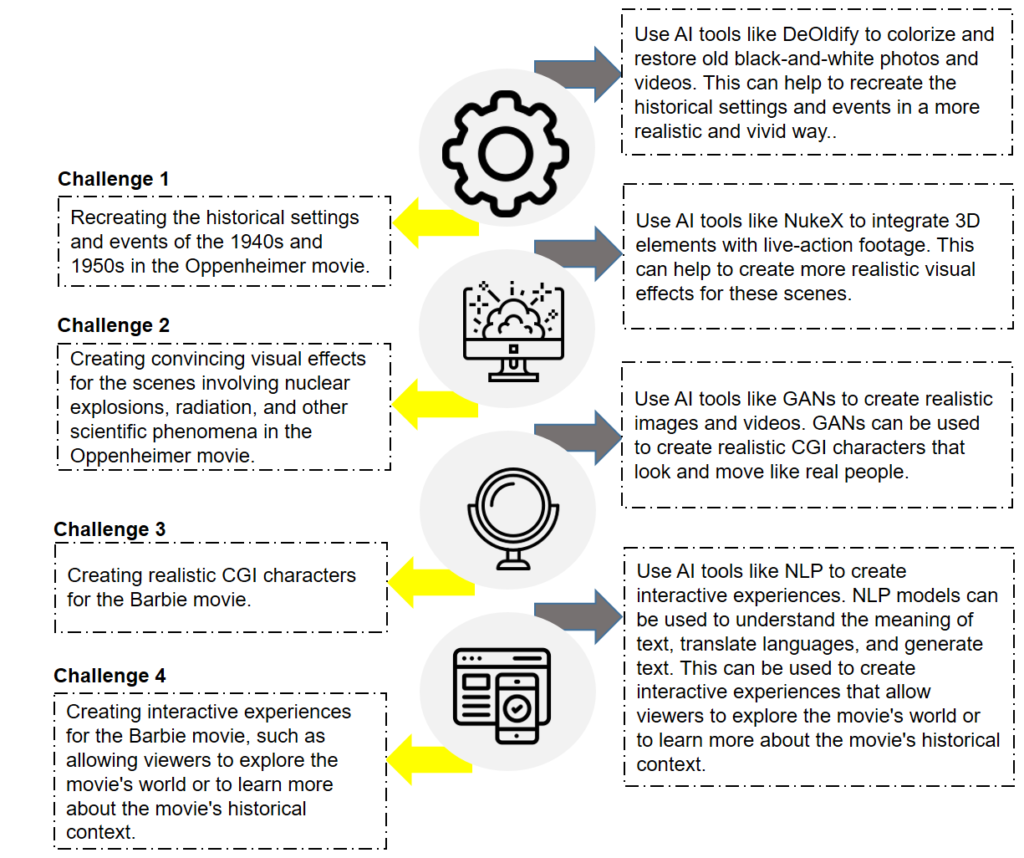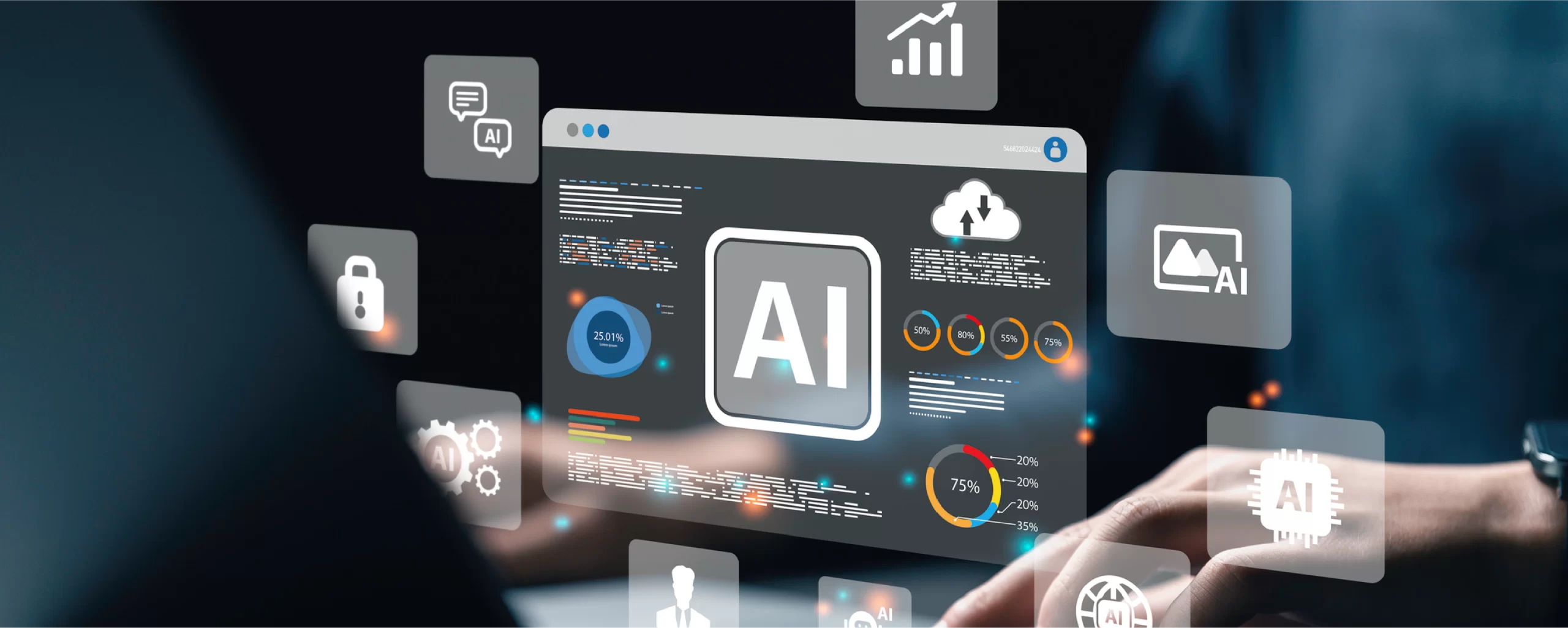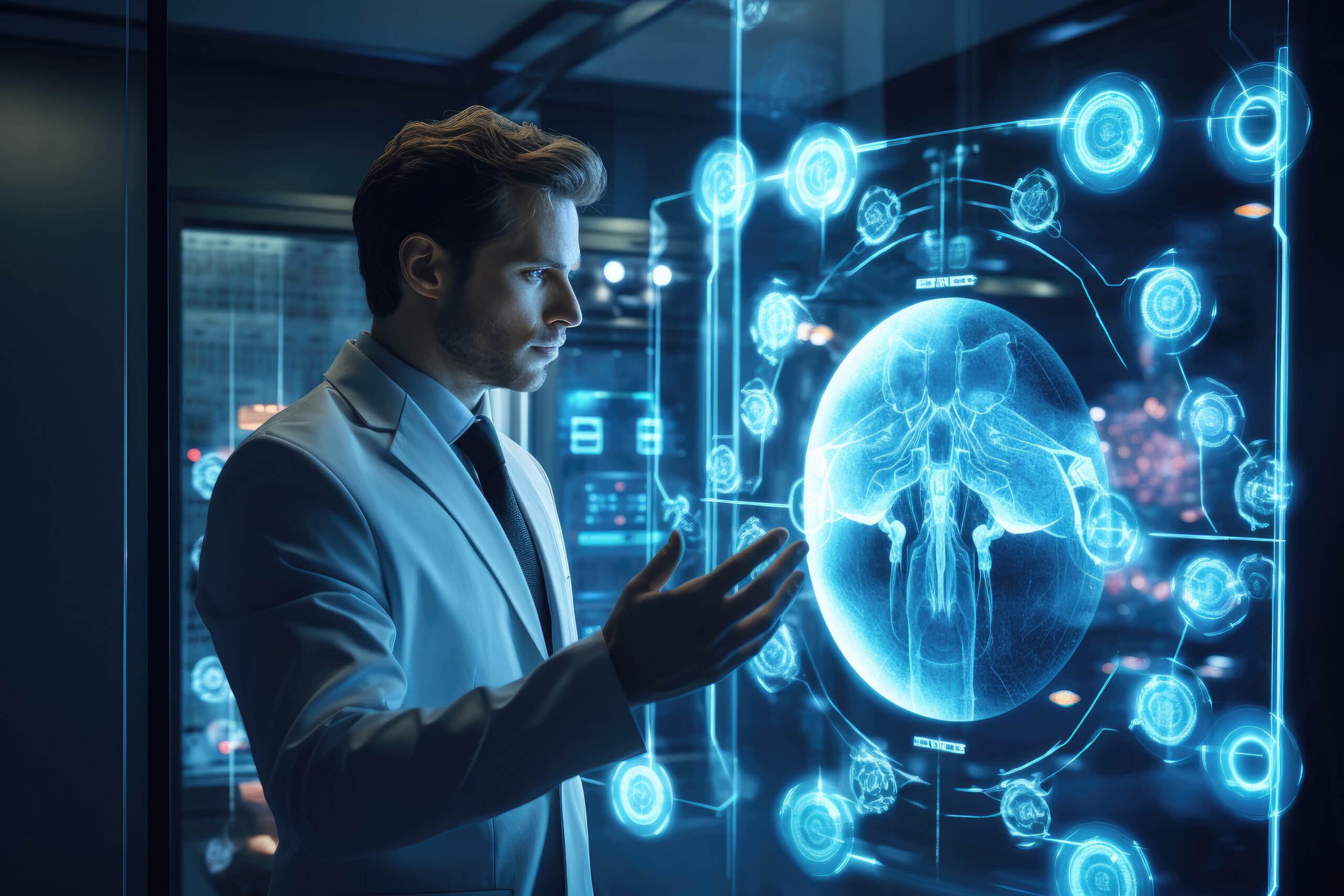Artificial Intelligence: Common Factor in Barbie & Oppenheimer
Artificial Intelligence, or AI in the film industry, is revolutionizing how movies are made and consumed. The current movies Barbie & Oppenheimer are the evidence. It is utilized in various filmmaking stages, such as scriptwriting, pre-production, production, post-production, and distribution. AI tools enhance filmmakers’ creative process, helping with tasks such as predicting a film’s success, selecting actors, designing graphics, and generating visuals. Using traditional CGI techniques alongside AI showcases the technology’s growing importance in the industry. AI tools like Mid-journey, Deep-fake, Runway, etc., have become invaluable for addressing challenges and improving storytelling.
Companies like OpenAI, Curious Refuge, Adobe, NVIDIA, etc., play a significant role in AI’s impact on filmmaking.
Filmmakers have harnessed various AI tools, including image generation, voice synthesis, video editing, and scriptwriting. Additionally, AI has been employed for predicting film success, selecting actors, and designing graphics, among other applications. Some recent developments, such as the Barbenheimer trailer, which combined elements from Oppenheimer and Barbie movies, sparked discussions about AI’s societal implications.
Role of AI in Barbie & Oppenheimer Movies
AI’s integration into the film industry has revolutionized filmmaking processes, enabling creative exploration, cost-effectiveness, and an immersive cinematic experience for viewers in movies like Barbie and Oppenheimer. The Oppenheimer movie used AI to develop new weapons systems or help clean up nuclear fallout. In the Barbie movie, it was used to create new products and services or to help Barbie with her everyday tasks.
AI was also used in various stages of the production process for both Barbie and Oppenheimer movies.

Fig 1: AI in production to the post-production process
AI Tools Empowering Oppenheimer & Barbie Movies
AI-based approaches are used in Oppenheimer and Barbie movies in various ways, such as:
Image Generation
- AI creates realistic and artistic images that combine the visual elements of both movies, such as the pink mushroom cloud, the pink suit and hat, and the Trinity Test toys of Barbie movie
- These images are created by AI artists using software such as Midjourney, and Runway
- These images can be used for fan art, posters, wallpapers, or even inspiration for new stories or movies
Video Editing
- AI merges scenes from both movies and other sources to create a coherent and humorous trailer for the crossover film
- When Robert Oppenheimer talked about the atomic bomb, a deep-fake AI tool was used that could generate realistic and convincing face-swaps
- Deep-fake tool also creates a video of Robert Oppenheimer when he quoted the Bhagavad Gita after witnessing the first nuclear test in New Mexico
Style Transfer
- You can use style transfer to produce unique and amusing images that juxtapose the serious and dark tone of Oppenheimer with the vibrant and cheerful tone of Barbie
- AI transfers the visual style of one movie poster to another, using a deep neural network that learns the features and characteristics of both posters
- This was performed in both movies to demonstrate their novel method for cross-domain style transfer
Marketing
- AI helps with the marketing strategies of both movies, such as partnerships, experiential marketing, and co-branded collaborations
- This was achieved by using AI tools such as HubSpot to compare and contrast the marketing differences between Barbie and Oppenheimer
- It helps to create a cultural phenomenon around the iconic doll and its live-action adaptation by Greta Gerwig
Creating Realistic CGI Characters
- In the Barbie movie, Generative Adversarial Networks have emerged as an essential AI tool for creating realistic CGI characters
- These machine-learning models were utilized to generate lifelike virtual actors, accurately mimicking human appearances and movements in both movies
Breaking Filmmaking Barriers: AI Innovative Solutions Tackling Challenges With Ease
Given below are some challenges and innovative solutions using AI tools in the Oppenheimer and Barbie movies:

Fig 2: Challenges and innovative solution
Promotional Images Using DALL-E 2 AI Tool:
- This AI image generator created promotional images for the Barbie movie
- It generated realistic images from text descriptions, and it was used to create the Barbie dolls, clothes, and accessories in the images
An AI-generated Trailer For A Crossover Film Called Barbenheimer
- It was a mash-up of dialogue and scenes from Barbie and Oppenheimer
- The result was a hilarious and absurd parody that imagines Margot Robbie’s Barbie joining Cillian Murphy’s Oppenheimer in the Manhattan Project
A Series Of Images That Juxtapose Oppenheimer’s Gritty Realism With Barbie’s Vibrant Universe
- The images showed Margot Robbie‘s Barbie in the world of Nolan’s Oppenheimer with pink clouds and smoke all over
- Cillian Murphy’s Oppenheimer is shown in Gerwig’s Barbie world, dressed in a pink suit and hat
Images Created From Text Prompts Using Midjourney Software
- BuzzFeed published a list of AI-generated images of Barbie dolls representing different countries
- It used text prompts to create these images using Midjourney software
Market Players Game-Changing Innovations
Below are recent AI-Based Innovations by Market Players transforming Oppenheimer and Barbie Movies:
- OpenAI’s GPT-3 language model helped to generate realistic dialogue and narration for some scenes in Oppenheimer and create promotional materials such as posters and trailers
- Curious Refuge, an AI filmmaking studio specializing in generating high-quality synthetic media such as images, videos, and audio, was used to create realistic simulations of nuclear explosions and historical events for Oppenheimer
- Adobe’s Sensei AI was utilized to edit and optimize Barbie’s visual effects and animation and personalize the content for different viewers based on their preferences and feedback
- Nvidia’s generative AI models, such as NVIDIA Picasso, created high-resolution, photorealistic images, videos, and 3D content for Barbie
Warner Bros. and their marketing agency, Bond, collaborated with PhotoRoom, an AI-based photo editing app, to create an exclusive Barbie filter. The special filter enables fans to morph into Barbie characters.
Conclusion
The role of AI in the film industry has evolved, becoming a potent creative partner. It enhances storytelling, visual effects, and audience engagement. Moreover, in the context of Barbie and Oppenheimer, AI’s transformative capabilities have addressed specific challenges. It has paved the way for immersive, captivating cinematic experiences that resonate with audiences worldwide.
As AI technology advances, it will bring forth further groundbreaking innovations in the film industry. This will reaffirm AI’s indispensable role in shaping the future of filmmaking. Movies such as Oppenheimer and Barbie movies will surely spark a conversation about the potential implications of AI and its impact on society.



